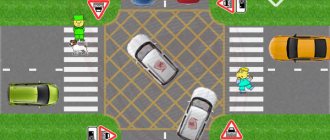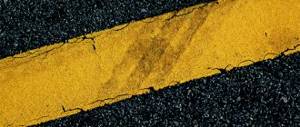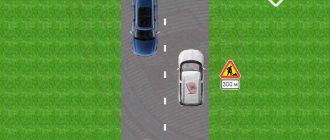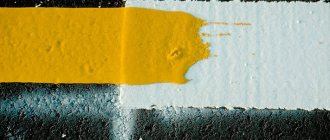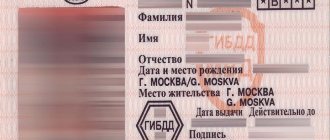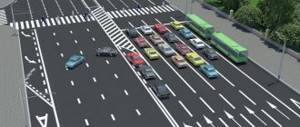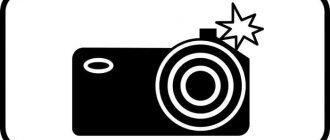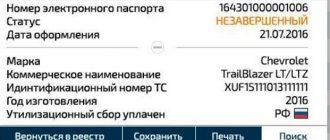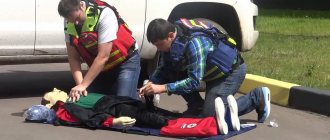Multi-colored markings may appear on Russian roads
Previously, GOST provided only three colors for road markings: white for most types of markings, yellow for places where stopping or parking is prohibited, orange for temporary markings.
Now permanent markings, which previously were only white or yellow, can be in other colors: red, blue, green and even black.
The point of such innovations is to separate marking lines that are more important for safety from those that are less important. For example, markings that indicate lanes within an intersection may now be blue. The same color can be used to mark the boundaries of parking spaces.
According to the new GOST, yellow will be used to indicate those zones where overtaking is prohibited.
The new markings on Russian roads, which are regulated by the GOST standard that came into force on June 1, 2021, will be more informative precisely due to the color variety. However, drivers do not have to learn when to use blue markings and when to use green markings. The lines themselves will remain the same, they mean the same as before, so the main thing is the form of the marking.
Will sparkle with new colors: why will blue markings appear on the roads?
The markings 1.16.1 - 1.16.3 indicating guide islands have been corrected. Markup 1.1 is excluded from the image. Now we can say for sure that the island is limited by marking 1.1, and the designation 1.16.1 - 1.16.3 is applied inside this island. Previously, there was an ambiguous understanding of the use of such markings and questions remained regarding the qualification of offenses.
Marking 1.26 “Waffle iron” can be applied from April 28, 2018.
It will be possible to use yellow and blue colors only after changes are made to the Traffic Rules, but not earlier than June 1, 2018. Today, the use of yellow is strictly limited, and blue is not provided at all.
Horizontal markings can be permanent or temporary. Permanent markings are white, except for lines 1.4, 1.10 and 1.17, yellow; temporary markings are orange.
This paragraph of the Traffic Rules should be changed in the near future.
Previously, GOST allowed only the following colors for road markings: white for most types of markings, yellow for places where stopping/parking is prohibited, orange for temporary markings.
Now permanent markings, which previously were only white or yellow, can also be in colors such as red, blue, green and even black.
The essence of such innovations is to separate marking lines that are more important for safety from less important ones. For example, markings indicating traffic lanes at intersections can now be blue. The same color is now allowed to mark the boundaries of parking spaces.
According to GOST, yellow is now allowed to indicate zones where overtaking is prohibited.
The new markings on Russian roads, regulated by the new GOST that came into effect on June 1, 2021, are more informative precisely because of their variety of colors. But motorists may take their time to learn when blue markings will be used and when green markings will be used. The lines themselves will be the same and will mean the same as before, and the main thing here is the form of the marking.
But what you really should pay attention to is new types of markup.
First of all, this is not yet a very common, but increasingly actively used “waffle iron” marking (car enthusiasts in the largest cities are already familiar with it). This marking indicates the intersection of roadways where it is prohibited to be present during a prohibitory traffic light.
The meaning of this marking is as follows: it prevents congestion at intersections. The driver, even if there is no such marking, has no right to enter the intersection if there is a traffic jam there or immediately behind it. When the traffic light phase changes from green to red, the car may remain at the intersection, as a result of which it will impede traffic from the transverse direction.
Doing something like this without a “waffle iron” was a violation of the rules and was punishable by a fine. However, in fact, such fines were issued very rarely.
“Waffle iron” will provide an opportunity to automate this process. Where it will be present, there will also be cameras for photographing violations, which will detect violators and automatically issue them fines.
Another innovation that you should be aware of is the markings indicating the place/area for turning. This will be an arrow on the corresponding sign, which will no longer confuse motorists. Because turning left is prohibited in turning places, and the markings in such places were made just like a left arrow. Naturally, drivers rely on signs, but the markings are often misleading.
Now, in places for turning around, the markings will clearly show that in this place you can only turn around, and you cannot turn left.
It is impossible to say exactly. Somewhere it may not appear soon. Since road GOSTs have been recommended and voluntary for many years. Which means that the new GOST is also a kind of guideline for road services, but not an obligation.
But even in cities where local services decide to apply the new GOST immediately, its implementation will take some time.
A common example of how this is done in Moscow (in other regions of the Russian Federation the process is similar):
- a traffic organization project is being prepared,
- the project is approved by the transport department,
- the project is sent to the housing and communal services department,
- the housing and communal services department sends the project to the executors - road services,
- new markings are applied during the period of scheduled work.
Therefore, it is not necessary that new markings will appear in Russia in 2021. Excluding, of course, “waffle irons”, which allow you to replenish the budget with paid fines.
New types of markings from June 1, 2021
But what is really worth paying attention to is the new types of markup.
Firstly, this is a “waffle iron” marking that few people are familiar with in practice, but is increasingly being implemented (drivers of the largest cities in the country are already familiar with it). With the help of this marking, an intersection of roadways is indicated where you cannot be present during the prohibitory phase of the traffic light.
The essence of this marking is that it prevents the formation of congestion at intersections. The driver, even if there is no such marking, should not enter the intersection if there is a traffic jam on it or immediately behind it. When the traffic light changes from green to red, the driver's car may remain at the intersection. which will interfere with movement from the transverse direction.
This, even without the “waffle iron” markings, was considered a traffic violation and was punishable by a fine. But in practice, such fines were issued extremely rarely.
The “waffle iron” marking will automate this process. Where it will be applied, cameras will most often be installed to photograph violations, which will detect violators and automatically issue them fines.
The second new thing you need to know about is the markings that indicate the place or area for a turn. It will look like an arrow on the corresponding sign and will no longer confuse drivers. The fact is that turning left is prohibited in places for turning around, but the markings in such places were carried out precisely as a left arrow. Of course, drivers should follow the signs, but the markings are often misleading in such situations.
Now, in places for turning around, the markings will clearly indicate that in this place it is only allowed to turn around, but turning left is not possible.
Waffle iron and charging station
In addition, several new signs will be introduced that will be applied to the asphalt. In particular, we are talking about a sign that will indicate a charging station for electric vehicles, as well as a “waffle iron” type marking. This is a zone into which entry is prohibited if there is a traffic jam at the intersection. By the way, this particular marking is already being used in the Russian capital as an experiment, and the new GOST simply legalizes it. In addition, the standard for the first time provides for an arrow that indicates the turning zone; the old version of GOST did not have it (there were only turning arrows).
When will the new road markings become widespread?
It's impossible to say for sure. In some cities it may not appear very soon. The thing is that road GOSTs have been of a recommended or voluntary nature for many years. This means that the new GOST is a certain guideline for road services, but they are not obliged to follow it.
But even where city services decide to use the new GOST right now, its implementation will take some time due to the peculiarities of the bureaucracy in the country.
A simple example of how this happens in Moscow (in other regions the procedure will be similar):
- a traffic organization project is being prepared,
- the project is approved by the Department of Transport,
- the project is sent to the housing and communal services department,
- the housing and communal services department sends the project to the executors - directly to the road services,
- new markings are applied during scheduled work.
Thus, it is not a fact that in 2021 new markings will appear on Russian roads at all. With the exception, of course, of the “waffle iron,” which helps replenish the budget through fines.
Legal formalities and reality
The new road regulations formally come into force on June 1, but the current order of the Russian government dated November 4 refers to the old GOST. A similar reference to the same old GOST is contained in the current Traffic Rules. Thus, an obvious contradiction arises between various regulatory documents. Officials say that until all these legal conflicts are resolved, the use of both old and new types of road markings is allowed.
In addition, there are many administrative and technical obstacles that slow down the application of the new GOST. For example, in Moscow, the corresponding changes must be approved by the city departments of transport and housing and communal services. Only after this the necessary orders will be transmitted to the contractor (GBU “Highways”). This organization, in turn, will apply new markings to the capital's highways as the asphalt surface is replaced as planned. In other regions of the country the situation is even more complicated. It can be assumed that the process will drag on for several months or even years.
Don't miss: What is the minimum pension in the Moscow region?
New colors
Now the markings on the road can be of four colors: white, yellow, orange or black (on the so-called “vertical” markings, for example, on bollards, bridge supports, etc.). The new standard adds three new marking colors at once:
- red;
- green;
- blue.
Most likely, the first two will be used to duplicate road signs. But blue color is used for marking 1.7, which marks the boundaries of traffic lanes within the intersection.
In addition, the new GOST allows the use of yellow for the most popular road markings (solid, intermittent, etc.) - it is assumed that yellow markings will be better visible in winter, when there may be snow on the roads.
Public transport stop
1.17
1.17.2
Now public transport stops are marked with marking 1.17, which is a broken yellow line running parallel to the sidewalk. The new marking with index 1.17.2 will also look like a broken line, but it will be applied perpendicular to the sidewalk. It will not be possible to park within the coverage area of the markings (only stopping to pick up or drop off passengers is allowed, and even then if there is no interference with public transport).
From June 1, 2021, a new GOST for road markings will come into force in Russia. It makes significant changes to already adopted standards. In particular, in addition to the usual white and yellow lines, blue markings will appear.
From June 1, 2021, a document entitled “Technical means of organizing traffic will come into force. Road markings. Classification. Technical requirements”, which provides for a new GOST for road markings. Let's look at the main changes.
Blue markings
One of the most important innovations is blue markings. It proposes to carry out elements that have the least impact on safety - traffic lines at intersections, parking spots, etc.
Yellow markings
But the most dangerous places, along with white, are proposed to be marked with yellow markings. We are talking, for example, about a continuous line in zones where overtaking or driving into the oncoming lane is prohibited. The yellow lines are supposed to be more visible to the driver, especially in winter.
Other markup requirements
The new GOST specifies the use of other new types of markings:
- “waffle” markings prohibiting stopping at an intersection;
- designation of places for charging electric vehicles;
- an arrow indicating a turn (previously, markings were used to indicate only a turn);
- two new types of pedestrian crossings.
When will the new markings appear on the roads?
The most interesting thing is that this document introduces new requirements for markings, but does not regulate their application, reports Avtospravochnaya.com. To start using it on the roads, all these changes must be spelled out in the text of the traffic rules, according to which the driver must act. If there are no new markings in the traffic rules, then the driver is not obliged to follow its requirements. And now the current text of the traffic rules generally refers to the previous GOST on markings. Therefore, the markings on the roads are unlikely to change in the near future.
What they say in the Federation of Car Owners
In a conversation with RT, the head of the FAR (Federation of Car Owners of Russia) Sergei Kanaev commented on the new blue and yellow color markings. He recalled that such markings have been used in Europe for a long time, but their purpose is not always the same.
“As for Russian roads and drivers, the most important task here is to provide maximum information about what awaits car owners ahead. This very difference between yellow and blue colors is just obvious so that drivers do not get confused. The colors are contrasting,” notes Kanaev. He noted that yellow indicates a prohibition, and blue indicates the moment when the driver is approaching a certain section of the road where he should be more careful. “What has been done in Rosstandart will be in demand by drivers,” the expert believes.
New road markings
Tram station
A new type of marking 1.17, indicating stopping places for route vehicles.
Stops for trackless vehicles are indicated by markings 1.17.1 - new marking number 1.17; for tram stops with tracks located in the center of the road, markings 1.17.2 have been added. It is applied on the roadway on both sides, has a width and pitch of 1 meter. Currently not included in the Traffic Rules.
Waffle iron
A new type of road marking 1.26, which has already received the unofficial name “Waffle Iron”.
1.26 (color - yellow) - designates a section of the intersection that is prohibited from entering if there is a traffic jam ahead along the route that will force the driver to stop, creating an obstacle to the movement of vehicles in the transverse direction, with the exception of turning right or left in the cases established by these Rules. The marking can be used independently or in conjunction with road sign 1.35.
Amended to the Traffic Rules from April 28, 2021.
U-turn
Added image of marking 1.18, indicating a turning lane.
